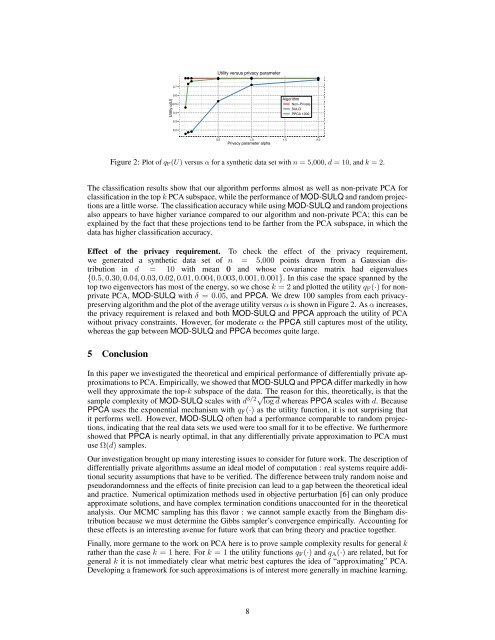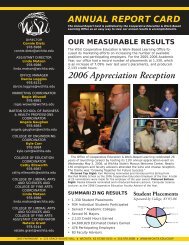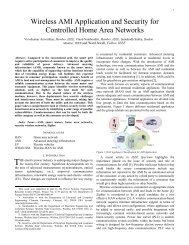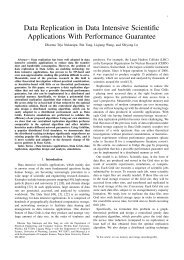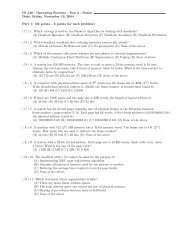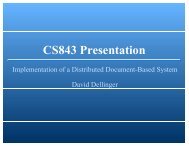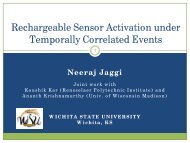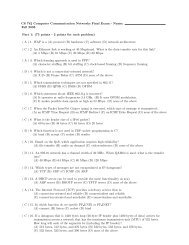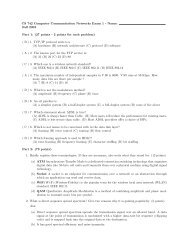Near-optimal Differentially Private Principal Components - NIPS
Near-optimal Differentially Private Principal Components - NIPS
Near-optimal Differentially Private Principal Components - NIPS
Create successful ePaper yourself
Turn your PDF publications into a flip-book with our unique Google optimized e-Paper software.
0.7●●●●●Utility versus privacy parameter●●●● ● ●Utility q(U)0.60.50.4●●AlgorithmNon−<strong>Private</strong>SULQPPCA 10000.30.2●● ●0.5 1.0 1.5 2.0Privacy parameter alphaFigure 2: Plot of q F(U) versus ↵ for a synthetic data set with n =5,000, d =10, and k =2.The classification results show that our algorithm performs almost as well as non-private PCA forclassification in the top k PCA subspace, while the performance of MOD-SULQ and random projectionsare a little worse. The classification accuracy while using MOD-SULQ and random projectionsalso appears to have higher variance compared to our algorithm and non-private PCA; this can beexplained by the fact that these projections tend to be farther from the PCA subspace, in which thedata has higher classification accuracy.Effect of the privacy requirement. To check the effect of the privacy requirement,we generated a synthetic data set of n = 5,000 points drawn from a Gaussian distributionin d = 10 with mean 0 and whose covariance matrix had eigenvalues{0.5, 0.30, 0.04, 0.03, 0.02, 0.01, 0.004, 0.003, 0.001, 0.001}. In this case the space spanned by thetop two eigenvectors has most of the energy, so we chose k =2and plotted the utility q F (·) for nonprivatePCA, MOD-SULQ with =0.05, and PPCA. We drew 100 samples from each privacypreservingalgorithm and the plot of the average utility versus ↵ is shown in Figure 2. As ↵ increases,the privacy requirement is relaxed and both MOD-SULQ and PPCA approach the utility of PCAwithout privacy constraints. However, for moderate ↵ the PPCA still captures most of the utility,whereas the gap between MOD-SULQ and PPCA becomes quite large.5 ConclusionIn this paper we investigated the theoretical and empirical performance of differentially private approximationsto PCA. Empirically, we showed that MOD-SULQ and PPCA differ markedly in howwell they approximate the top-k subspace of the data. The reason for this, theoretically, is that thesample complexity of MOD-SULQ scales with d 3/2p log d whereas PPCA scales with d. BecausePPCA uses the exponential mechanism with q F (·) as the utility function, it is not surprising thatit performs well. However, MOD-SULQ often had a performance comparable to random projections,indicating that the real data sets we used were too small for it to be effective. We furthermoreshowed that PPCA is nearly <strong>optimal</strong>, in that any differentially private approximation to PCA mustuse ⌦(d) samples.Our investigation brought up many interesting issues to consider for future work. The description ofdifferentially private algorithms assume an ideal model of computation : real systems require additionalsecurity assumptions that have to be verified. The difference between truly random noise andpseudorandomness and the effects of finite precision can lead to a gap between the theoretical idealand practice. Numerical optimization methods used in objective perturbation [6] can only produceapproximate solutions, and have complex termination conditions unaccounted for in the theoreticalanalysis. Our MCMC sampling has this flavor : we cannot sample exactly from the Bingham distributionbecause we must determine the Gibbs sampler’s convergence empirically. Accounting forthese effects is an interesting avenue for future work that can bring theory and practice together.Finally, more germane to the work on PCA here is to prove sample complexity results for general krather than the case k =1here. For k =1the utility functions q F (·) and q A (·) are related, but forgeneral k it is not immediately clear what metric best captures the idea of “approximating” PCA.Developing a framework for such approximations is of interest more generally in machine learning.8


